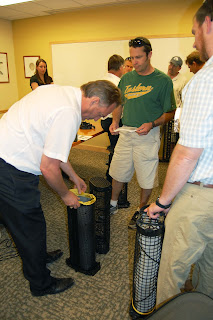A team of three Australians representing the company SEAPA
visited the Judd Gregg Marine Research Complex last Friday as part of their efforts
to expand sales and offer expertise to existing users of their equipment. The
team - Garry Thompson, Leon Stott and his wife Chris - talked with local oyster farmers about high quality basket developed by
SEAPA to improve oyster quality and decrease labor costs for farms in Australia,
France, Prince Edward Island and Cape Cod. N.H. Sea Grant marine aquaculture
specialist Michael Chambers arranged for the presentation to provide new
equipment options that might help oyster farmers improve their operations.
There are currently seven individuals and partners that have
permits for oyster farms in Great Bay, although some are in the early stages of
setup. Those that have been established for a few years typically use “oyster
condos” to grow the shellfish, made out of heavyweight mesh bags that slide
horizontally into a PVC tower that remains underwater. However, a lot of
biofouling — a term used to describe a build-up of barnacles, algae and other
aquatic organisms on hard structures under the water — grows on the equipment,
requiring the oyster farmers to power spray the equipment regularly. In
addition to the increased labor costs, it can be a physically demanding part of
the job because the biofouling adds a lot of weight to the equipment.
Above: Ray Grizzle, professor of zoology at UNH, scrubs a bag full of young oysters with a sturdy brush to remove biofouling. These bags are part of the oyster condo setup typically used in Great Bay oyster farms.
The SEAPA company, based out of Adelaide in South Australia,
partnered with Garon Plastic to design oyster baskets made of sturdy injection
molded plastic mesh. The baskets have clips that allow them to hang from line
anchored to wooden posts in the intertidal zone of a bay. The lines can be
pulled up and attached at various heights on the posts, allowing the oysters to
be out of the water for part of the day. This reduces biofouling, slows down
the oyster shell growth and enables the oyster meat to grow bigger.
In many areas of the world, including Prince Edward Island, these
lines and posts do not interfere with most people’s ability to enjoy the beauty
of the water. But in Great Bay, oyster farmers face the challenge of balancing
the need to farm effectively with the desire of the waterfront homeowners to
have an unobstructed view of the water.
Unlike New England, the areas outside of the metropolitan
regions of South Australia are sparsely populated. The residents accept views
of the oyster farms as a reminder that there are jobs available that help grow
clean, healthy oysters to supply market demand, the team explained. That said,
the SEAPA containers are versatile and could be stacked in a similar manner as
the current oyster condos used in Great Bay or set up in a different manner
altogether to meet everyone’s needs.
Above: Great Bay oyster farmers Chris Phillips, Jon Bunker and Jess Cranney took a closer look at the SEAPA baskets to determine if that gear might work for their operations.
Below: Garry Thompson demonstrates how the liner sock goes into the baskets to keep the tiny oysters from escaping.
For more information
on SEAPA, please visit www.seapa.com.au.




It's awesome for me to have a web site, which is good in favor of my experience. thanks admin
ReplyDeleteAlso visit my web site Online vergleichen: Internet ohne Schufa